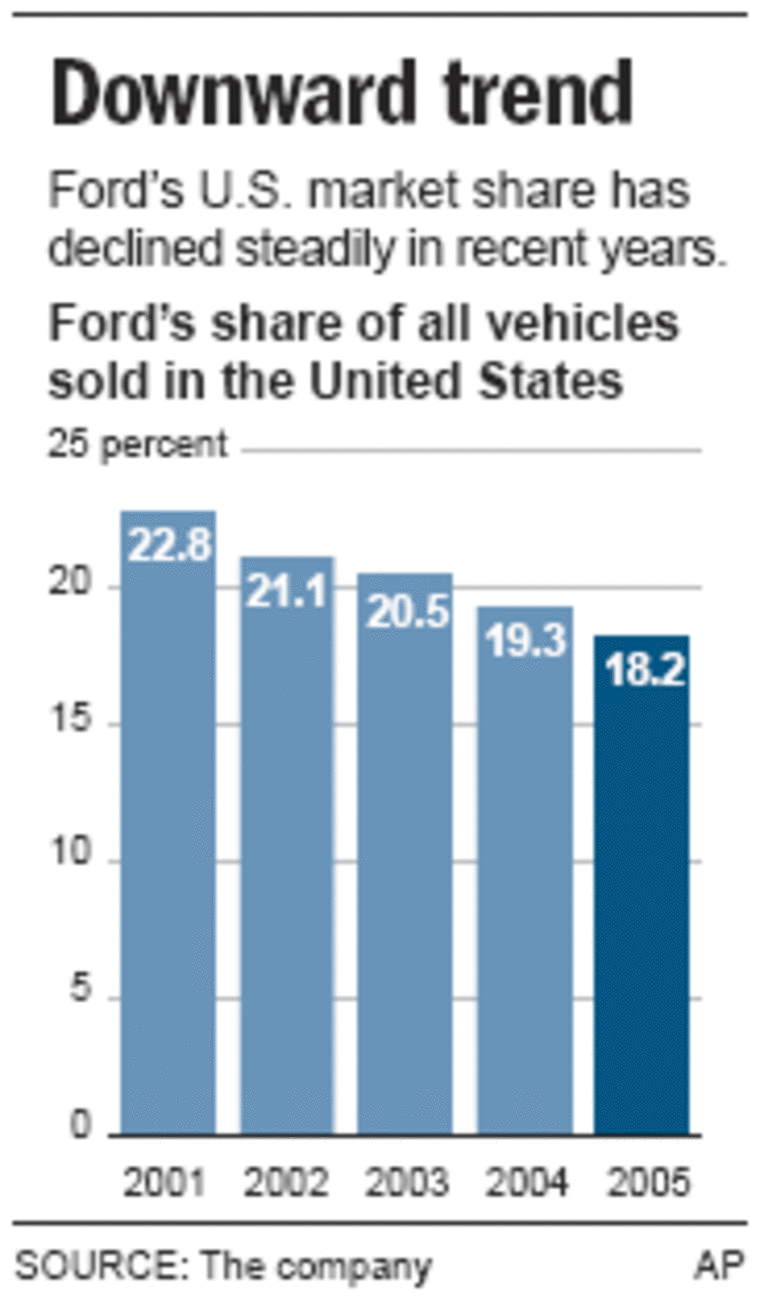Ford’s accelerated plan to close factories and cut one-third of its work force will boost the automaker’s bottom line, but the nation’s oldest car company will only turn its business around if it rapidly refocuses its product line, analysts said Friday.
In a dramatic restructuring designed to rein in expenses and restore it to profitability, Ford said Friday it would cut its annual costs by about $5 billion by the end of 2008 and cut its salaried staff by about a third. The company said Thursday it would offer buyouts to virtually all its hourly workers with the aim of cutting the unionized work force by nearly 40 percent.
The struggling automaker also said its troubled North American auto operations would not be profitable on a full-year basis before 2009, a year later than originally projected.
While Ford has taken aggressive steps to reduce its costs, critics say the company’s product line remains too bland and overly focused on out-of-favor pickup trucks and sports utility vehicles. The company now needs to produce compelling line of products that can drive up revenue, said Rebecca Lindland, an automotive analyst with Global Insight.
“They are attacking the financial side; they are making the cuts that hurt, but on the product and revenue side they have got to get back in the design studio and get some attractive cars out there,” she said. “It’s like dieting and exercise — there’s only so much dieting you can do, and everyone knows it’s the hardest part of staying in shape.”
Ford Chairman Bill Ford, in a statement explaining the cost-cutting decision, implicitly acknowledged the need for new models, saying the company’s problems have been due in part to “rapid shifts in consumer demand that affect our product mix.”
But Lindland says her firm does not expect Ford’s big new products — the Ford Edge “crossover” vehicle and Ford Fairlane SUV — to generate blowout sales.
“We don’t see a lot of net gain for any of their new products, and that’s a big problem. The only exciting products at Ford are coming out of their Land Rover division,” she said.
Ford risks slipping further behind both its Asian competitors and domestic brands, said Lindland.
Although Chrysler has seen great success with its 300 sedan, the U.S. unit of DaimlerChrysler also is losing money, the company said Friday.
Meanwhile GM is more aggressive in marketing crossover vehicles, which tend to be lighter than standard SUVs and get better gas mileage. Crossovers, which blend the ride and style of a passenger vehicle with the practicality of a SUV, are the fastest-growing segment of the U.S. vehicle market.
“We see Ford in trouble from all sides, and GM could eat their lunch as well,” she said. “They need to use their understanding of the U.S. market and build great American cars. Toyota, Nissan and Honda don’t have the 100-plus year heritage that the Big 3 can take advantage of. Real-wheel drive and V8 engines — those are the things that make an American car. They need to build vehicles with an American attitude that you just don’t see any more.”
Ford appears to be taking steps to answer such criticisms, announcing on Friday that 70 percent of it product line will be either new models or significantly upgraded by 2008.

Mark Fields, president of Ford’s Americas operations Friday said it was a “misconception” to think the company has been ignoring new product design.
“My intent is that, going forward we bring that to the next level,” Fields said on CNBC. “We have to do and we are going to do a much better job of leveraging our global architecture to spin more products through product development.”
Friday’s announcement, an update of the “Way Forward” plan initially announced in January, comes a bit more than a week after the appointment of Alan Mulally, a longtime Boeing Co. executive, to success Bill Ford as chief executive officer.
Mulally and Ford face a plethora of problems, including a dwindling market share, with sales so far this year off some 10 percent from year-ago levels. Sales of the company's bread-and-butter vehicles like the F-Series pickup truck — a major contributor to Ford’s bottom line — are tumbling in the face of higher gasoline prices, as car buyers opt for more fuel-efficient models from Asian carmakers.
But Mulally, who has been praised for engineering a resurgence in Boeing’s commercial airplane unit over the past few years, might be the turnaround expert Ford now desperately needs, said Kevin Reale, an analyst at Boston-based AMR Research.
“The biggest opportunity Ford has now is its transition from a company obsessed with reducing costs to one that’s a market driver with competitive products,” Reale said.
“One of the best things they have done in that regard is bring in Alan Mulally,” he said. “Mulally did a lot to transform the aircraft division at Boeing when the bottom fell out of the aircraft industry after the Sept. 11 attacks, and after cutting costs he was able to come up with exciting new products, such as the 787 Dreamliner."
Still, other key figures are leaving Ford. On Thursday the company said two of its top executives have decided to retire, most notably Anne Stevens, the chief operating officer of the automaker’s Americas unit and a key architect of the “Way Forward” plan. David Szczupak, vice president of manufacturing, is also stepping down.
Ford also is said to be considering other major changes, although the company Friday ruled out the immediate sale of its Jaguar brand. Other reports have suggested the company might be angling for a role in the Renault-Nissan alliance led by industry guru Carlos Ghosn or considering the sale of its consumer finance unit, Ford Motor Credit.